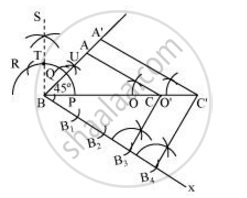Advertisements
Advertisements
Question
Draw a triangle ABC with side BC = 7 cm, ∠B = 45°, ∠A = 105°. Then, construct a triangle whose sides are `4/3 `times the corresponding side of ΔABC. Give the justification of the construction.
Solution
∠B = 45°, ∠A = 105°
Sum of all interior angles in a triangle is 180°.
∠A + ∠B + ∠C = 180°
105° + 45° + ∠C = 180°
∠C = 180° − 150°
∠C = 30°
The required triangle can be drawn as follows.
Step 1
Draw a ΔABC with side BC = 7 cm, ∠B = 45°, ∠C = 30°.
Step 2
Draw a ray BX making an acute angle with BC on the opposite side of vertex A.
Step 3
Locate 4 points (as 4 is greater in 4 and 3), B1, B2, B3, B4, on BX.
Step 4
Join B3C. Draw a line through B4 parallel to B3C intersecting extended BC at C'.
Step 5
Through C', draw a line parallel to AC intersecting extended line segment at C'. ΔA'BC' is the required triangle.

Justification
The construction can be justified by proving that
`A'B = 4/3 AB, BC' = 4/3BC , A'C' = 4/3 AC`
n ΔABC and ΔA'BC',
∠ABC = ∠A'BC' (Common)
∠ACB = ∠A'C'B (Corresponding angles)
∴ ΔABC ∼ ΔA'BC' (AA similarity criterion)
`=>(AB)/(A'B) = (BC)/(BC') = (AC)/(A'C') ....1`
In ΔBB3C and ΔBB4C',
∠B3BC = ∠B4BC' (Common)
∠BB3C = ∠BB4C' (Corresponding angles)
∴ ΔBB3C ∼ ΔBB4C' (AA similarity criterion)
`=>(BC)/(BC') = `
`=>(BC)/(BC') = 3/4 ...(2)`
On comparing equations (1) and (2), we obtain
`(AB)/(A'B) = (BC)/(BC')=(AC)/(A'C') = 3/4`
`=> A'B = 4/3 AB, BC' = 4/3 BC, A'C' = 4/3 AC`
This justifies the construction.
APPEARS IN
RELATED QUESTIONS
Draw a triangle ABC with BC = 7 cm, ∠B = 45° and ∠A = 105°. Then construct a triangle whose sides are`4/5` times the corresponding sides of ΔABC.
Draw a line segment of length 7 cm and divide it internally in the ratio 2 : 3.
Draw a right triangle in which the sides (other than hypotenuse) are of lengths 5 cm and 4 cm. Then construct another triangle whose sides are 5/3th times the corresponding sides of the given triangle.
Draw a triangle ABC with side BC = 6 cm, ∠C = 30° and ∠A = 105°. Then construct another triangle whose sides are `2/3` times the corresponding sides of ΔABC.
If A(–14, –10), B(6, –2) is given, find the coordinates of the points which divide segment AB into four equal parts.
Δ AMT ∼ ΔAHE. In Δ AMT, MA = 6.3 cm, ∠MAT = 120°, AT = 4.9 cm, `(MA)/(HA) = 7/5`. construct Δ AHE.
Draw seg AB of length 9.7 cm. Take a point P on it such that A-P-B, AP = 3.5 cm. Construct a line MN ⊥ sag AB through point P.
For ∆ABC in which BC = 7.5cm, ∠B =45° and AB - AC = 4, select the correct figure.
Draw a line segment of length 7 cm. Find a point P on it which divides it in the ratio 3:5.
Two line segments AB and AC include an angle of 60° where AB = 5 cm and AC = 7 cm. Locate points P and Q on AB and AC, respectively such that AP = `3/4` AB and AQ = `1/4` AC. Join P and Q and measure the length PQ.
